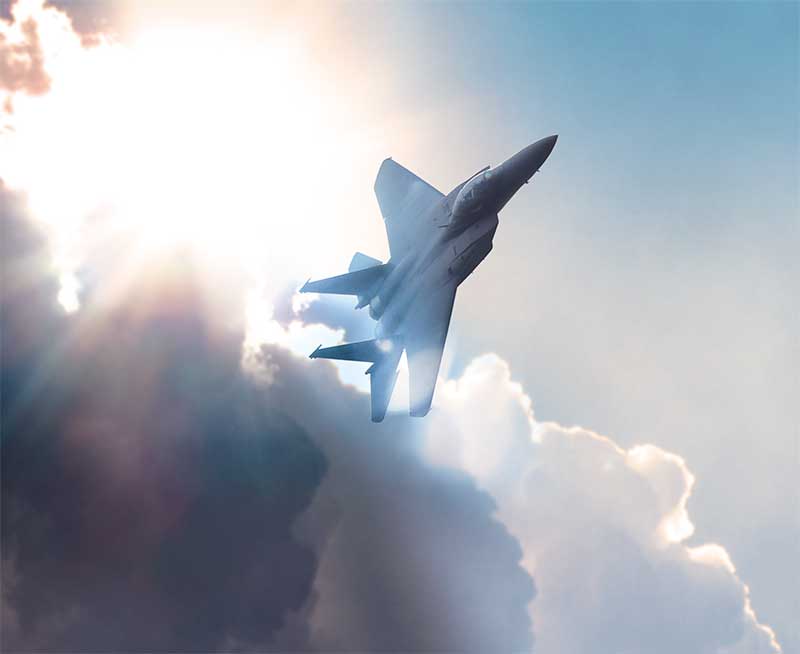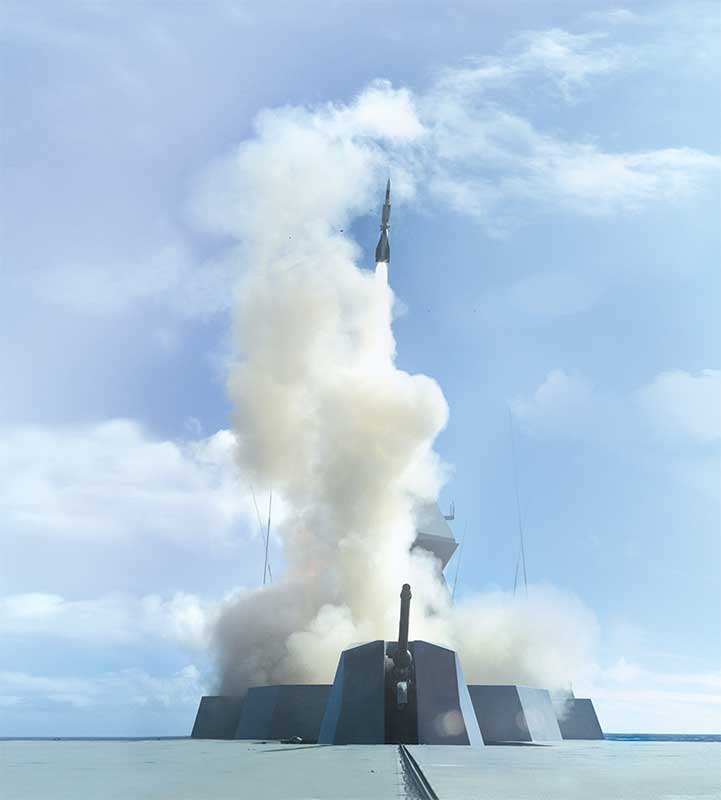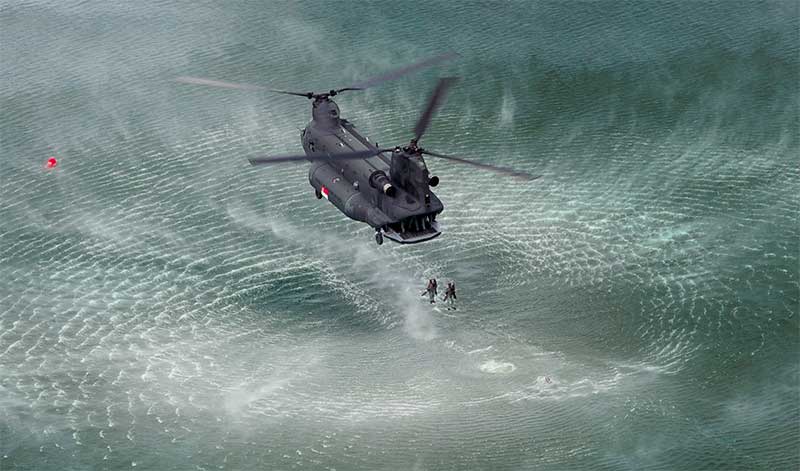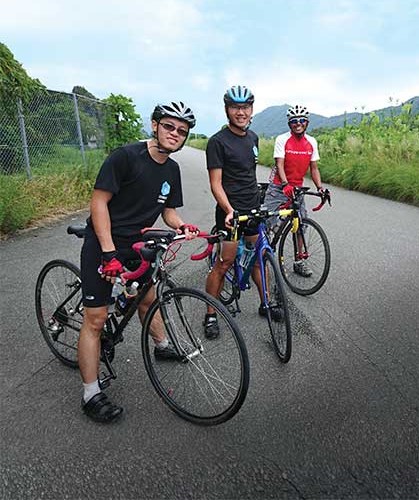With terrorism on the rise, the Republic of Singapore Air Force's (RSAF's) defence of Singapore's airspace from possible attacks has become more important than ever.
A civilian airliner has been hijacked and is approaching Singapore's airspace. The RSAF receives information about the situation, and a decision is made to activate its fighter jets.
Back at the Command Post, the Air Operations and Systems Experts (AOSXs) are keeping a close watch on the airliner to monitor its flight path and parameters to update commanders on its compliance. The fighters scramble to intercept as the airliner is unresponsive to air traffic control instructions.
Meanwhile, Ground-Based Air Defence (GBAD) assets are put on high alert to track the aircraft closely. The fighters proceed to intercept and escort the aircraft to land at a designated airstrip. Once the airliner lands, troops from the Singapore Police Force cordon the plane and the hijackers are apprehended.
While situations like this feel unfamiliar in a seemingly safe Singapore, there is no guarantee that it will not happen. Given today's security environment, terrorism can take place anywhere and anytime and the RSAF is always ready to ensure that no intruders enter our skies.
Commander Air Defence and Operations Command Brigadier-General (BG) Tan Chee Wee said: "Since the September 11 attacks in 2001, the RSAF has maintained a heightened air defence alert posture to guard against terror threats from the air." Explaining that these threats can come in different forms, be it a hijacked civilian airliner or a lone wolf in a light civilian aircraft, BG Tan added that such threats are real and present, given Singapore's position as one of the busiest aviation hubs in the region.
In early August, a potential attack on Singapore was foiled when six terror suspects were arrested for allegedly trying to hit Marina Bay with rockets fired from Batam.
During his visit to the United States (US) in August, Prime Minister Lee Hsien Loong announced Singapore's continued contributions to the fight against terror and said: "We are a target of ISIS (Islamic State of Iraq and Syria) anyway. The JI (Jemaah Islamiyah) were looking for us before we did anything and before we knew they existed.
"If they see Indonesia and Malaysia as legitimate targets, all the more Singapore is a rational, open, cosmopolitan country, and not what they think countries should be, and therefore should be attacked. So do not think that by lying low, we are not going to be a target."
"If (terrorists) see Indonesia and Malaysia as legitimate targets, all the more Singapore...is not what they think countries should be. So do not think that by lying low, we are not going to be a target."
- Prime Minister Lee Hsien Loong
ME3 Ajmehar is part of the team that keeps a watchful eye on the skies to prevent intruders from entering into Singapore.
Eagle eye
With air surveillance as the first line of defence, AOSXs like Military Expert (ME) 3 Ajmehar Kaur form part of the team that remains vigilant 24/7, looking out for any unauthorised flights entering Singapore's airspace.
Speed is of the essence in her job and there is always an adrenaline rush when it comes to identifying an unknown aircraft within minutes.
"It's important for us to maintain close civil-military relations. For example, we work with the Civil Aviation Authority of Singapore (CAAS) to get information on inbound and outbound flights," she said.
The 51-year-old from 203 Squadron (SQN) explained that all authorised aircraft passing through Singapore airspace will file a flight plan with the CAAS and be in contact with Singapore Air Traffic Control once it enters Singapore's Flight Information Region. This is a specified region of airspace in which a flight information service and an alerting service are provided. While in flight, the aircraft should maintain itself in a predetermined airway and report at certain beacons.
"Once we detect an unknown aircraft approaching our airspace, we will contact all the relevant agencies to request information on the flight," said ME3 Ajmehar. "We will then highlight it to the duty air defence commander."
While split-second decisions are being made at the higher management level with all the information gathered, ME3 Ajmehar and her team will keep a watchful eye on the aircraft and provide regular updates to the commander on its movement.
Tracking flights
AOSXs also rely on radars to provide a comprehensive picture of the air traffic. These radars operate at different ranges, overlapping each other to ensure that no traffic is missed. A long-range radar such as the FPS 117 can cover up to 460km, while short-range radar sensors like the Giraffe Agile Multiple Beam cover up to 60km.
The surveillance team also works closely with the Republic of Singapore Navy (RSN) to stay informed of any helicopters that may have taken off from a foreign ship passing through Singapore's sea lanes or coming in to dock at a naval base.
ME3 Ajmehar said: "We will communicate with RSN vessels in that area for them to check and identify the helicopter with the rest of the ships. "We also work with the RSN to obtain information about the movement of heli-capable ships around our waters, so you can be assured that nothing slips through the team."
When surveying the skies, ME3 Ajmehar does not stand for any complacency. When called upon, she and her team will react immediately to ensure that the skies are protected.
"We are not going to let anyone just enter our airspace without us knowing what their intentions are. After all, you wouldn't just let someone that you don't know into your home."
Pilots and WSO (Fighters) of F-15SGs hone their skills in large-scale overseas exercises such as the biennial Exercise Forging Sabre, held in Arizona.
MAJ Liow participates in regular air defence exercises to train for counter-terror operations.
Fighting together
Up in Singapore's skies, a pair of armed F-15SGs close in on the approaching unknown aircraft.
"Unknown aircraft, we are the Republic of Singapore Air Force armed fighters. You are approaching Singapore territorial airspace. You are to comply with all our instructions or risk being enagaged." The first warning transmission goes out from the airborne pilots.
Major (MAJ) Peter Liow explained that once the fighter aircraft are scrambled, they follow specific instructions from the controllers and position themselves to intercept the unknown aircraft. This involves showing their presence to the aircraft's pilot and establishing communications over radio.
"In the event that the pilot does not respond, we will have to use visual signals, such as rocking the wings, to establish our intent. At the same time, we look out for any telltale signs of possible aggression, such as manoeuvring towards us."
The F-15SG Weapon Systems Officer (WSO) (Fighter) from 142 SQN added: "The nature of warfare has changed. We are no longer talking about fighting between nations; we're talking about nations against non-state actors such as ISIS.
"Like what Prime Minister Lee said, Singapore is a target for ISIS, whether or not we join the US coalition. We must remain vigilant and ready to defend against any attacks on Singapore."
He noted that there has been an increase in the complexity of exercises to better prepare troops against the threat of terrorism. "We conduct air defence exercises
regularly so that our air defence team can hone our skills and proficiency in handling such threats. More and more agencies participate in our air defence exercises, strengthening our linkages and allowing us to better understand what one another does."
Strike down
While inter-agency exercises are increasingly necessary, the RSAF also sees value in honing its skills alongside international players. An example is the Red Flag exercise series in the US, which RSAF fighters participate in regularly.
Noting that this series of exercises is a platform for troops to train among international air assets, MAJ Liow explained that the realism of such exercises allows him to sharpen his thinking process.
"For example, mission commanders have to coordinate the route and roles for hundreds of aircraft, and learn to orchestrate the sequence of events to achieve mission success with minimal loss of assets.
"We seldom get this kind of training when we are operating among ourselves."
Exercises like these also provide opportunities for the RSAF pilots and WSO (Fighters) to work with and improve their interoperability with their international counterparts.
Above all, such exercises serve one main purpose to ensure that nobody touches Singapore.
"We will (continue to) build upon our knowledge and training... One thing's for sure we will be ready when we are called upon."
During deployment, the SPYDER operators consist of a six-man team: a team commander or Air Warfare Officer, two Air Defence Systems Specialists, two Air Defence Weapons Operators and one ADWS.
After being posted to 165 SQN as an ADWS, 3SG Lee learnt that every role, no matter how big or small, has a part in contributing to Singapore's air defence.
Ground defenders
Keeping air threats at bay is not all about relying on the fighters, as most people might think.
The RSAF's multi-layered, networked air defence system sees the first or outer layer formed by the fighters. Its intermediate and inner layers are covered by GBAD shooters such as the I-Hawk, which has a range of up to 40km, and the Surface-to-air PYthon-5 and DERby (SPYDER), which has a range of 15km.
When the fighters are scrambled to intercept potential threats, the personnel operating the GBAD systems are also put on high alert. After transporting the SPYDER to the area of deployment and setting it up, the team is on standby, ready to take down any threat that comes their way.
"The SPYDER can take down fighter jets, helicopters, Unmanned Aerial Vehicles, wide-body aircraft and precision munitions. If the aerial threats fire a missile or drop a bomb on us, we will be able to intercept it with our missiles," said 3rd Sergeant (3SG) Shaun Lee.
On the two missiles which the SPYDER uses, the Air Defence Weapons Specialist (ADWS) from 165 SQN explained: "The Python-5 uses imaging infrared technology to track its target. The head of the Python-5 cools to a low temperature before the missile is launched, and the difference in temperature (between the missile seeker and the target, which is usually at a high temperature) makes it easy for the missile to find the threat," said 3SG Lee.
In the case of the Derby, its active radar system tracks the target. Once the Derby has locked on to the target, the operator can fire the missile to take it down.
Besides being in round-the-clock standby operations, the weapon operators also train with a range of aircraft. The different aircraft will play the role of the attackers to provide realistic training for the GBAD operators. For instance, the former may attack at different angles, speeds and altitudes.
On the constant training, 3SG Lee said: "We cannot be complacent. We always make sure that we train hard and we train realistically, so that when the time comes, we will be able to perform to task."
Always on the lookout
The 22-year-old Full-time National Serviceman also revealed that he was one of the air defenders on duty for the Shangri-La Dialogue held earlier this year. The annual defence dialogue sees delegates from more than 50 countries coming to Singapore to discuss security and defence issues.
Initially, 3SG Lee was stressed, but he quickly overcame it with his officers' and senior specialists' encouragement and assurance on what he should watch out for.
"When I went on station to man the SPYDER launcher, they told me not to be nervous, as it would cause my mind to be blank and I might lose focus more easily," said 3SG Lee.
"When I wasn't operating the system, we had prowling duties around our deployment ground to make sure that our site was secure."
3SG Lee admitted that he had had no idea what air defence was, prior to entering National Service, but after being posted to 165 SQN and operating the SPYDER, he realised the importance of his role and that every layer of air defence, no matter how big or small, was crucial in protecting the nation's skies.
During the recent ADMM-Plus Maritime Security and Counter-Terrorism exercise, Special Forces teams roped from the SPs to storm a building to take down terrorists. This is one of the capabilities that the SPs possess.
CPT Tan feels that soft skills such as contingency planning and threat analysis which RSAF personnel pick up every day will prove to be useful during a crisis.
Lending a Super hand
If you had read about the ASEAN Defence Ministers' Meeting (ADMM)-Plus Maritime Security and Counter-Terrorism exercise held in May this year, you would have seen photos of Special Forces teams roping down from the RSAF's Super Puma helicopters (SPs) to storm buildings and ships.
"It (the exercise) was a showcase of our counter-terrorism abilities -- one of the things you see us do is the ship storming to rescue the vessel hijacked by terrorists," said Captain (CPT) Calvin Tan.
The SP pilot from 126 SQN added that, with the recent emphasis on developing counter-terrorism operations, cooperation between the Army and the RSAF had become tighter over the years.
Talking tactics
When flying in the SP, the leader of the troops will be the sole communicator between his team and the pilots. Through radio communications, the SP pilots will update him on instances such as when the troops should prepare for roping.
The leader will then communicate the message via hand signals to the rest of his crew.
CPT Tan explained: "It's not as simple as just dropping a bunch of guys onto a ship or building and letting them storm the place. Much has to be done in terms of threat analysis, planning and establishing communications and linkages, for the operation to succeed.
"For example, what do they require the SPs to do, what's the best way of storming the ship, when do they need us to inform them to standby for roping."
The 29-year-old added: "It takes a lot of practice to achieve synergy and execute a drill to perfection. In counter-terrorism, the margin of error is very thin -- nothing must go wrong."
The advantages of working with the SPs for soldiers include exploiting vantage points and quickly getting to certain areas which are inaccessible to ground troops -- a capability highly valued during urban fighting scenarios.
"Compared to conventional warfare, counter-terrorism operations call for an even higher level of skill, experience and synergy between troopers and flight crew. This level of preparedness is what we are training for today," said CPT Tan.
"Because the mission is always fluid, these are abilities which will prove to be valuable when it's crunch time."





